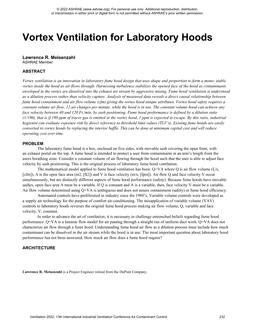Click here to purchase
Vortex ventilation is an innovation in laboratory fume hood design that uses shape and proportion to form a mono- stable vortex inside the hood as air flows through. Harnessing turbulence stabilizes the opened face of the hood as contaminants enveloped in the vortex are dissolved into the exhaust air stream by aggressive mixing. Fume hood ventilation is understood as a dilution process rather than velocity capture. Analysis of measured data reveals a direct causal relationship between fume hood containment and air flow volume (cfm) giving the vortex hood unique attributes. Vortex hood safety requires a constant volume air flow, 12 air changes per minute, while the hood is in use. The constant volume hood can achieve any face velocity between 40 and 120 Ft./min. by sash positioning. Fume hood performance is defined by a dilution ratio (1/190), that is if 190 ppm of tracer gas is emitted in the vortex hood, 1 ppm is expected to escape. By this ratio, industrial hygienist can evaluate exposure risk by direct reference to threshold limit values (TLV’s). Existing fume hoods are easily converted to vortex hoods by replacing the interior baffle. This can be done at minimum capital cost and will reduce operating cost over time.
Product Details
- Published:
- 2022
- Number of Pages:
- 9
- Units of Measure:
- Dual
- File Size:
- 1 file , 1000 KB
- Product Code(s):
- D-IIVC2022-C036
- Note:
- This product is unavailable in Russia, Belarus
